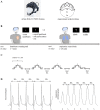Confounding effects of heart rate, breathing rate, and frontal fNIRS on interoception
- PMID: 36450811
- PMCID: PMC9712694
- DOI: 10.1038/s41598-022-25119-z
Confounding effects of heart rate, breathing rate, and frontal fNIRS on interoception
Abstract
Recent studies have established that cardiac and respiratory phases can modulate perception and related neural dynamics. While heart rate and respiratory sinus arrhythmia possibly affect interoception biomarkers, such as heartbeat-evoked potentials, the relative changes in heart rate and cardiorespiratory dynamics in interoceptive processes have not yet been investigated. In this study, we investigated the variation in heart and breathing rates, as well as higher functional dynamics including cardiorespiratory correlation and frontal hemodynamics measured with fNIRS, during a heartbeat counting task. To further investigate the functional physiology linked to changes in vagal activity caused by specific breathing rates, we performed the heartbeat counting task together with a controlled breathing rate task. The results demonstrate that focusing on heartbeats decreases breathing and heart rates in comparison, which may be part of the physiological mechanisms related to "listening" to the heart, the focus of attention, and self-awareness. Focusing on heartbeats was also observed to increase frontal connectivity, supporting the role of frontal structures in the neural monitoring of visceral inputs. However, cardiorespiratory correlation is affected by both heartbeats counting and controlled breathing tasks. Based on these results, we concluded that variations in heart and breathing rates are confounding factors in the assessment of interoceptive abilities and relative fluctuations in breathing and heart rates should be considered to be a mode of covariate measurement of interoceptive processes.
© 2022. The Author(s).
Conflict of interest statement
The authors declare no competing interests.
Figures





References
Publication types
MeSH terms
LinkOut - more resources
Full Text Sources

